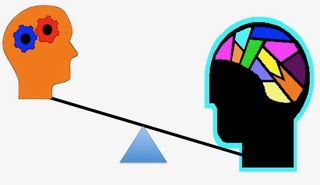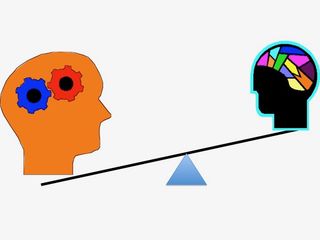Magical Thinking
Matter- but Not Mind-blind—and Vice Versa
The more mentalistic you are, the less you are able to understand reality.
Posted July 12, 2017
According to the diametric model of cognition, we have evolved two parallel modes of cognition: mechanistic for interacting with the physical world of objects and mentalistic for dealing with the psychological world of the mind, which in turn is key to our ability to function socially.
However, the model predicts problems if the wrong mode is selected: treating people as if they were objects, or objects as if they were people. The former is likely to get you diagnosed autistic, the latter diagnosed psychotic. But although there is now a very plausible neuro-anatomical basis for these parallel modes in what have been describe as “anti-correlated” networks in the cerebral cortex as explained in previous posts, to date empirical evidence for mentalistic and mechanistic cognition varying inversely in a similar way has been scarce, as a recent study notes.

As the authors of the new study also point out, there is robust evidence that believers in the supernatural rely heavily on intuition, and notably less on analytical thinking. Findings about mentalizing are fewer, but they indirectly indicate that believers’ physical understanding might be impaired. Believers in the paranormal and religion have been shown to take such statements as “Earth wants water” or “Force knows its direction” more literally true than skeptics, who interpret the statements more metaphorically:
In the present study, we therefore examined how physical-world skills and knowledge of the non-social world predict religious and paranormal beliefs. We addressed self-reported systemizing, intuitive physics skills, mechanical ability, mental rotation, school grades in mathematics and physics, common knowledge about physical and biological phenomena, and the way the participants assign mentality to non-mental phenomena. Measures of intuitive and analytical thinking were also included for comparison. We hypothesize that all of these variables predict both religious and paranormal beliefs.
Two hundred and fifty eight Finnish participants (63.6 percent women) took part in the online study. Their mean age was 31.81 years (SD = 9.89, range 18– 65). Of the participants, 38.1 percent were working, 44.4 percent were students, and 17.5 percent were employed in other activities; 1.2 percent had grammar school education, 44.2 percent had vocational or upper secondary school education, and 54.5 percent had polytechnic or university education. Religious affiliations were none (61 percent), Christian (37 percent), or other (2 percent).
The more the participants believed in religious or other paranormal phenomena, the lower their intuitive physics skills, mechanical and mental rotation abilities, school grades in mathematics and physics, and knowledge about physical and biological phenomena were; the less they reported interests and skills in systemizing; and the more they regarded inanimate targets as mental phenomena. These correlational results were specified with a factor analysis and regression analyses where age, gender, education, and thinking styles were controlled for. The results showed that a physical capability factor, representing most physical skills, interests, and knowledge, still had a unique effect on supernatural beliefs but a second factor, representing school grades in mathematics and physics, did not.
The present results are thus among the first to empirically demonstrate that several kinds of skills, interests, and knowledge that concern the physical world are poorer among supernatural believers than among other people. Although the unique explanatory power of the physical variables were not high, the results support Badcock’s (2009) argument that if the physical world is not well understood, mental concepts such as agency and intentionality expand to the whole universe, resulting in beliefs in demons, gods, and other supernatural phenomena. The results are important because the reasons why people find supernatural explanations compelling is poorly understood and because the role of physical cognition in encouraging supernatural beliefs has not been adequately addressed.
Of all variables, the strongest correlation was found between supernatural beliefs and assigning mentality to physical processes, lifeless matter, artificial objects, and living but inanimate phenomena. Although the researchers exemplified the concepts of a thought, human beings, and God as “mental,” and the concepts of a car and a pen as “non-mental,” believers in the supernatural nevertheless assigned mentality to light, wind, metal, oil, clothes, paper, flowers, and other inanimate things more than the skeptics did. When examined more closely, the researchers found that assigning mentality to inanimate phenomena tapped both physical interests and abilities, and such specific ontological confusions as “Stones sense the cold.”

Finally, the authors put their findings in the larger context of the diametric model, commenting that
As a whole, the importance of poor understanding of physical phenomena and exaggerated mentalizing in supernatural beliefs suggest that believers are preoccupied with mentality and absent-minded in physical phenomena, in a similar way that some others are preoccupied with machines and other physical systems, but absent-minded on mental phenomena. Supernatural beliefs may thus reflect a broad, hyper-mentalistic cognitive phenotype, opposite to the hyper-mechanistic phenotype. Extreme forms of hyper-mechanistic phenotype can be found among individuals with Autism spectrum disorder, ASD (…). ASD individuals have a drive to analyze and construct mechanical, numerical, and other inanimate systems, but they can be mind-blind; they can have deficits in attribution of mental states to others, they can ignore the special significance of mental events, and their view of other people can be limited to external behavior rather than mental states (…). The ability to distinguish mental from physical seems to be impaired both among ASD individuals and supernatural believers, although its manifestation is reversed. Because findings from hyper-mentalistic and hyper-mechanistic cognition, as two opposite phenotypes, can help each other in the search for their underlying mechanisms, one promising approach for future studies might be to integrate research on this newly found “matter-blindness” to research on “mind-blindness.”
I could not agree more: As I have suggested in a previous post, blindness to biological reality combined with a flair for reading the minds of others was a notable feature of Trofim Lysenko's disastrous career as Czar of Soviet agronomy, and one that sets a worrying precedent for the present in general and for genetics/epigenetics in particular.
(With thanks to Amar Annus for bringing this to my attention.)




